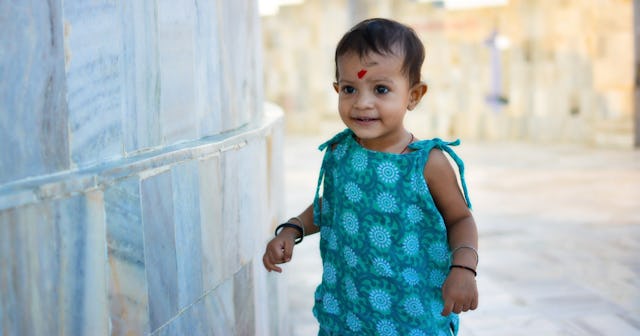What Are The Stages Of Language Development In Children?

Of all the milestones in your child’s life, hearing them say their first word is one of the biggest. Here you have this baby that’s now been in your care for around a year and, after getting to know and understand them during that time, you finally have the opportunity to start to communicate with them using words. It’s also kind of mind-blowing when you think about how these once-tiny, squishy babies end up turning into walking, talking mini-adults (even though that’s pretty standard at this point in human development). Of course, they don’t go from cooing in their crib to expressing themselves in complete sentences overnight — there are stages of language development.
RELATED: Start Communicating With Your Baby Using These Easy Baby Sign Language Tips
But as a new parent, you may not be familiar with those stages. That’s totally understandable! Since you’re here, though, it’s clear you’re ready to discover what comes after your baby’s first coos. So, here’s what to know about the four stages of language development in early childhood.
What is language development in children?
In general, young children tend to follow a similar progression through four steps of language development. Before we go any further, let us be clear: There is no set timeline for this happening. Sure, there are approximate ages when a child typically reaches a particular stage. But every child is different, and these guidelines should not make you panic. If it gets to the point where you are concerned about your kiddo’s language development later on, by all means, discuss this with their pediatrician. Having said that, if your baby isn’t babbling in repetitive patterns by the time they’re eight-months-old, it’s likely not something to worry about.
It’s also important to keep in mind that there are several different language development theories. These theories vary in how they take into consideration both nature and nurture and favor certain approaches over others. So again, if your child doesn’t follow a timeline, that doesn’t mean that there’s something wrong with their language development.
What are the four stages of language development?
While there can be a lot of variation, language development in children does tend to follow this pattern of four broad categories, or stages. (And as a reminder, the ages included here are approximate!)
Stage 1: Babbling
Typically happens when a baby is between six and eight-months-old, and involves repetitive patterns of consonants followed by vowels (i.e. ma/ma, da/da, ga/ga, etc).
Stage 2: One-word stage
Also known as the holophrastic stage, this typically occurs when a child is between nine-months-old and 18-months-old, and involves communicating via single words, or a single word stem (i.e. doggy, no, stop, etc).
Stage 3: Two-word stage
This one is exactly what it sounds like: when your little one speaks in basic two-word sentences. It typically occurs in toddlers between the ages of 18 and 24 months (i.e. doggy bark, mommy hat, etc).
Stage 4: Early multiword stage
Also known as the telegraphic stage, this is when children are asked to repeat sentences, and when they do, leave out a few words (i.e. “I can see a cow” repeated as “See cow”). Toddlers typically reach this stage between 24 and 30 months.
What are the most critical years in a child’s development?
Helping your child grow is an ongoing process, but the crucial years of development start from the moment they’re born, to five years old. The relationships they form and the experiences they have during their first five years of life have a huge impact on their brain’s growth. This period is filled with sensitive milestones that are key to their cognitive development.
Do girls develop language before boys?
Starting with a reminder that gender is a social construct, this is a question that has been researched quite a bit. In the early 2000s, several studies were published which appeared to confirm the idea that baby girls start speaking earlier than baby boys. More recent research challenged these findings, examining if it’s another example of nature versus nurture, and/or potentially some type of gene. But in general, just remember that all kiddos develop at their own pace — and you’re doing just fine, Mama.
Are there activities to encourage speech and language development?
Each kid is different and moves at their own pace when it comes to talking. So there is nothing wrong with needing an extra push. Here are a few exercises you can practice with your sweetheart at home.
- First things first, your television shouldn’t be your child’s teacher. Conversing with people helps your baby find their words, not the TV.
- Say simple words to your baby like “da”, “ma”, “ba”, “aa” or “ooh.” These sounds are in your baby’s speech range and is a great start to getting your kiddo to talk. Eventually, they’ll copy you and start forming their own string of sounds.
- Narrate to your child what you are doing. If you are cooking or cleaning up, talk about your actions. This helps your baby learn which words mean what actions.
- Read to your child whenever you can. Not only will this instill a love for learning and grow their imagination, but matching words to colorful pages helps strengthen their understanding.
- Use hand gestures when speaking with your nugget. If you’re an expressive person and already talk with your hands, this should be a breeze. When teaching your baby a song, clap your hands or wave goodbye to them when you leave. You want your baby to link certain gestures with certain words. This will help them understand words and their meaning.
- Sing to your baby. When there’s a rhythm and words rhyme, it’s much easier for your baby to learn words. It may even encourage them to sing along. There’s a reason there are so many nursery rhymes. Pick one and have fun!
This article was originally published on